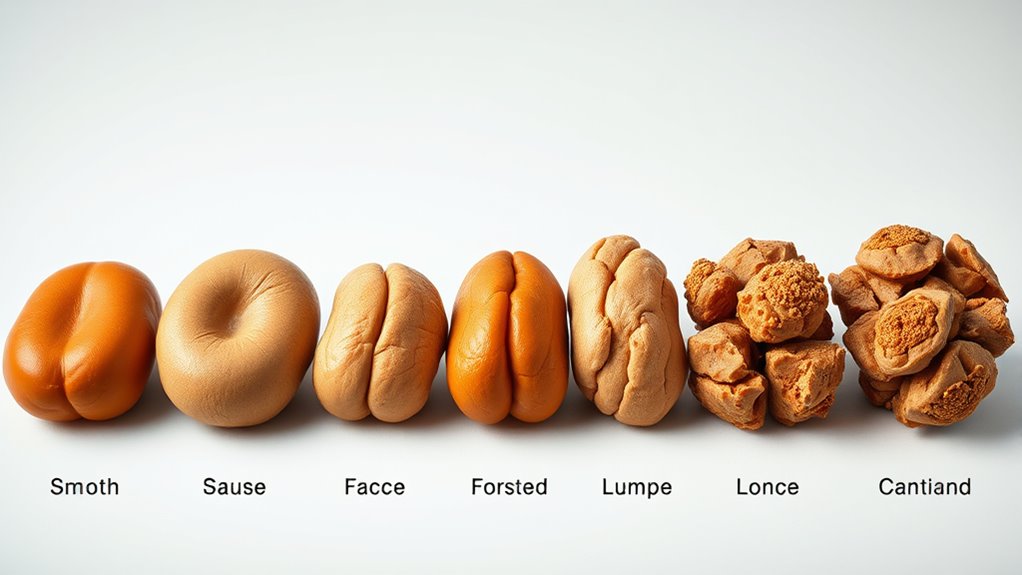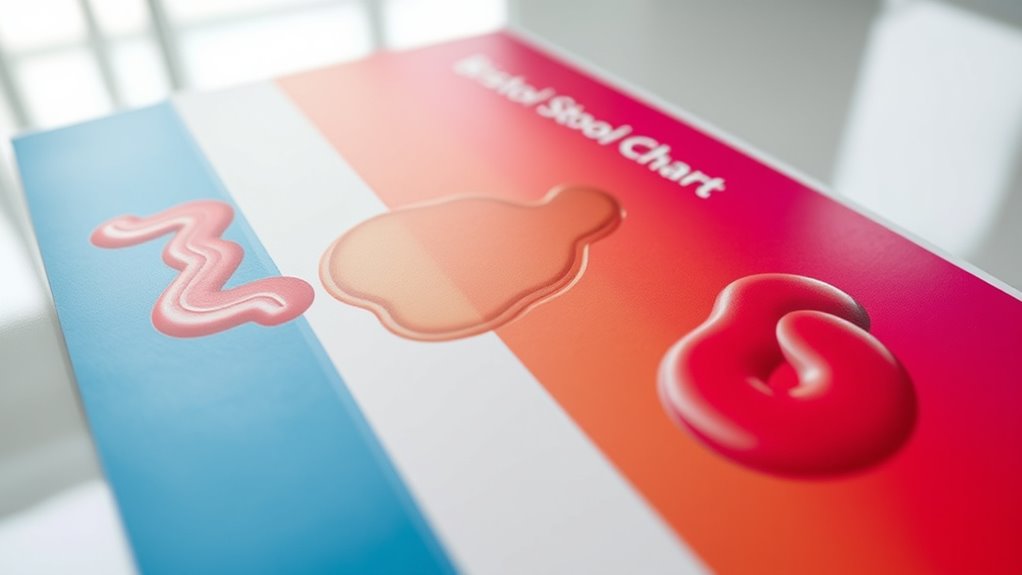The Bristol Stool Chart shows how your poop shape reveals your digestive health. Firm, lumpy stools suggest constipation, while loose or watery ones may mean irritation or imbalance. Ideal stools are soft, sausage-shaped, indicating good hydration and gut function. Your stool type can help you understand your body’s signals and identify issues early. Want to discover what your poop shape says about you? Keep exploring for more insights.
Key Takeaways
- The Bristol Stool Chart categorizes stool types from hard lumps to liquid, indicating digestive health and bowel transit time.
- Soft, sausage-shaped stools (Types 3-4) typically signal healthy digestion and proper hydration.
- Hard, lumpy stools (Type 1) may suggest constipation or slow colon movement.
- Loose or watery stools (Types 6-7) can indicate digestive upset, dehydration, or dietary imbalance.
- Monitoring stool shape helps detect potential issues early and guides diet or lifestyle adjustments for better gut health.

The Bristol Stool Chart is a simple tool I often use to assess bowel health. It’s a visual guide that helps me understand what my stool says about my digestive system. One of the key factors it highlights is stool consistency, which can tell us a lot about our overall gut health. I’ve learned that the consistency of my stool is influenced heavily by my diet, especially my intake of dietary fiber. When I consume enough fiber-rich foods like fruits, vegetables, and whole grains, my stool tends to be softer and easier to pass. This is because dietary fiber adds bulk and absorbs water, promoting a healthy, regular bowel movement.
The Bristol Stool Chart helps me assess gut health by monitoring stool consistency influenced by diet and fiber intake.
On the other hand, if I notice my stool is too hard or lumpy, it’s a sign that I might need to increase my fiber intake. Hard, pellet-like stools are often associated with constipation, which can happen when stool moves too slowly through the colon. In contrast, very loose or watery stool might be a sign that I need to cut back on certain foods or that I’m dealing with some digestive upset. The stool types on the Bristol Chart range from hard lumps to entirely liquid, giving me a quick reference to gauge my bowel health. I’ve found that aiming for a stool type that’s soft and smooth, similar to a sausage or snake, is usually a good indicator that my digestion is functioning well.
Understanding stool consistency allows me to make better dietary choices. If I notice my stool is consistently hard, I’ll intentionally add more high-fiber foods to my meals. Conversely, if my stool becomes too loose, I’ll adjust my diet to include more binding foods and stay hydrated. It’s fascinating how a simple shape or consistency can reflect so much about my health. I’ve also learned that lifestyle factors like stress, hydration, and exercise influence stool consistency just as much as diet does. Additionally, the choice of paints and coatings in my home projects can sometimes affect indoor air quality and overall well-being, highlighting the importance of choosing the right materials for a healthy environment.
Using the Bristol Stool Chart regularly helps me stay aware of my bowel health without overthinking it. It’s a quick, non-invasive way to check in with my body and catch potential issues early. I encourage anyone to familiarize themselves with the chart because understanding stool consistency isn’t just about comfort—it’s about maintaining good digestive health. When I pay attention to the signals my stool sends, I feel more in tune with my body and can make smarter choices to keep my gut happy and healthy.
Frequently Asked Questions
How Often Should I Check My Stool Type?
I recommend doing a stool assessment schedule that matches your health needs, but generally, checking your stool type once a week is enough for most people. Frequent monitoring isn’t necessary unless you notice sudden changes or discomfort. Pay attention to any signs of irregularity or issues. Regularly observing your stool can help catch problems early and make certain your digestive health stays on track.
Can Diet Alone Change My Stool Shape?
Coincidentally, I found that diet can definitely change my stool shape. I’ve noticed that increasing my fiber intake and staying well-hydrated helps produce softer, more regular bowel movements. It’s amazing how small adjustments like eating more fruits, vegetables, and drinking enough water can make a big difference. So yes, your diet alone can influence your stool shape, especially when you focus on fiber and hydration habits consistently.
What Causes Sudden Changes in Stool Consistency?
Sudden changes in stool consistency often happen because of shifts in fiber intake or hydration levels. If I suddenly eat more fiber or drink more water, my stool can become softer or more formed. Conversely, cutting back on fiber or dehydration can cause it to harden. Stress, illness, or medication can also play a role. Paying attention to my diet and hydration helps keep my stool consistent and healthy.
Is the Bristol Stool Chart Applicable to Children?
Yes, the Bristol Stool Chart can be useful for evaluating child stool and pediatric digestion. I find it helpful to compare my child’s stool shape to the chart’s types, which can indicate hydration levels or digestion issues. While it’s not a diagnostic tool, it offers a simple way to monitor health. Always consult a pediatrician if you notice persistent changes or concerns about your child’s stool patterns.
Can Medications Alter My Stool Classification?
You might be surprised, but yes, medications can definitely alter your stool classification. I’ve seen how medication side effects, like altered gut motility or changes in water absorption, can turn your stool into a different shape or consistency. Chronic illness impact also plays a role, making your bowel movements more unpredictable. It’s always good to keep track and discuss these changes with your healthcare provider to ensure everything’s balanced.
Conclusion
Did you know that about 70% of your immune system is in your gut? Understanding the Bristol Stool Chart helps you tune into your digestive health and catch issues early. By paying attention to your poop’s shape, you can spot potential problems before they become serious. So next time you hit the bathroom, remember—your stool is more than waste; it’s an essential sign. Stay mindful, stay healthy!









